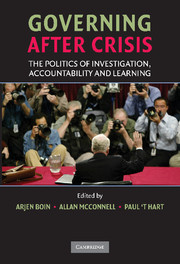Book contents
- Frontmatter
- Contents
- List of illustrations
- List of tables
- Contributors
- Introduction
- Part I Crisis-induced accountability
- 2 Weathering the politics of responsibility and blame: the Bush administration and its response to Hurricane Katrina
- 3 A reversal of fortune: blame games and framing contests after the 3/11 terrorist attacks in Madrid
- 4 Flood response and political survival: Gerhard Schröder and the 2002 Elbe flood in Germany
- 5 The politics of tsunami responses: comparing patterns of blame management in Scandinavia
- 6 Dutroux and dioxin: crisis investigations, elite accountability and institutional reform in Belgium
- Part II Crisis-induced policy change and learning
- Conclusion
- Index
- References
3 - A reversal of fortune: blame games and framing contests after the 3/11 terrorist attacks in Madrid
Published online by Cambridge University Press: 04 June 2010
- Frontmatter
- Contents
- List of illustrations
- List of tables
- Contributors
- Introduction
- Part I Crisis-induced accountability
- 2 Weathering the politics of responsibility and blame: the Bush administration and its response to Hurricane Katrina
- 3 A reversal of fortune: blame games and framing contests after the 3/11 terrorist attacks in Madrid
- 4 Flood response and political survival: Gerhard Schröder and the 2002 Elbe flood in Germany
- 5 The politics of tsunami responses: comparing patterns of blame management in Scandinavia
- 6 Dutroux and dioxin: crisis investigations, elite accountability and institutional reform in Belgium
- Part II Crisis-induced policy change and learning
- Conclusion
- Index
- References
Summary
Introduction
With only 3 days to go, Prime Minister José María Aznar and his ruling Popular Party (PP) appeared certain of victory in the general elections to be held on 14 March 2004. Pushing a firm antiterrorist agenda – read: anti-ETA (Euskadi Ta Askatasuna) – and conservative fiscal policies, Aznar's PP held a comfortable 5 percent lead in the polls over the socialist contenders. Aznar's designated successor (Aznar had announced his retirement), former Interior Minister and Vice Prime Minister Mariano Rajoy, thus seemed a near certainty to continue the 8-year-old PP government.
The attacks of 11 March 2004 in Madrid changed all that. A series of bomb explosions on four trains heading to one of Madrid's main stations killed 192 persons and wounded 1,430. In addition to the horror and grief caused by the onslaught, Spain witnessed a stunning political shift. The socialist opposition led by José Luis Rodríguez Zapatero won the elections just three days later.
Crises are often thought to foster solidarity, a phenomenon commonly known as the ‘rally-’round-the-flag' effect. Following the 9/11 attacks in the United States, President George W. Bush's hitherto meagre job approval rating shot up 35 to 40 percentage points. Likewise, the public's appreciation for Tony Blair's leadership as prime minister rose (on a ten-point scale) from 5.07 to 5.55 after the terrorist attacks in London on 7 July 2005. The fate of the Spanish government thus sharply contrasts with the fates of its western partners.
- Type
- Chapter
- Information
- Governing after CrisisThe Politics of Investigation, Accountability and Learning, pp. 62 - 84Publisher: Cambridge University PressPrint publication year: 2008
References
- 15
- Cited by



